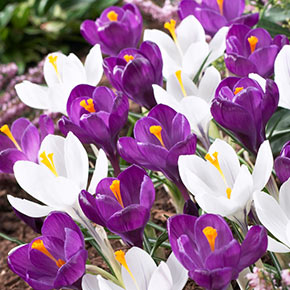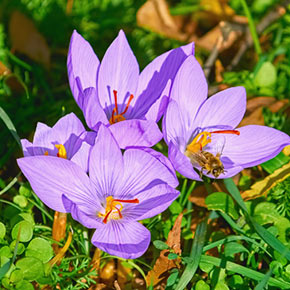-
Spring Planting
Order now for best selections.
-
Fall Planting
Available for preorder for fall 2025 delivery.
-
Bulk Flower Bulbs
Big savings on bulk orders!
- New
-
Gardening Resources
Flower Bulbs & Perennials at Wholesale Prices

How to Plant, Grow, and Care For Crocus
| Botanical Name | Crocus |
| Plant Type | Flower bulb |
| Sun Exposure | Full sun to partial shade |
| Soil Type | Well-drained clay, loamy or sandy soils |
| Soil pH | Neutral to slightly acidic |
| Bloom Time | Late winter to early spring |
| Flower Color | Purple, blue, white, yellow |
| Hardiness Zones | 3, 4, 5, 6, 7, 8, 9 |
| Special Features | Crocuses come back year after year and naturalize. Saffron Crocus blooms in the fall. |
Often considered a symbol of joy and new beginnings, crocus flowers are some of the first flowers to bloom in late winter and early spring. The low-growing plants add pops of color in flower beds and under trees—and they look spectacular when planted by the hundreds or thousands and grown in lawns for a spring meadow effect. While not a true bulb (they are corms), crocus are like other spring-blooming bulbs—they are easy to grow and low maintenance. They are also a food source for bees.

How to Plant Crocus Bulbs
To keep your crocus bulbs in the best condition, plant them soon after they are delivered. If you can't plant them right away, open the cartons. If the bulbs are in plastic bags, remove them from the plastic. Place them on a tray in a cool, dark, dry, well-ventilated area until you can plant them. Do not store them at temperatures below 39°F.Plant crocus bulbs in large drifts using groupings of 20-30 bulbs. Don't plant them too close to summer flowers—crocus can't handle heavy summer watering, so watering nearby plants may drown them. Plant crocus bulbs in well-drained soil, rich in organic matter. Place the bulbs 2-4 inches deep and space them about 2-3 inches apart. The pointy side of the corm should be facing up. Water thoroughly after planting.
Materials You'll Need
While a shovel or trowel is great for digging, some gardeners prefer using an auger and drill. Both the Improved Bulb Auger and KneeSaver Planting Tool are time savers. Using an all-natural, slow-release fertilizer, like Van Bourgondien 100% Natural Bulb Food, at planting time can also give your crocus a boost.How to Grow Crocus
Crocus are winter hardy and very low-maintenance bulbs. Here are a few tips for making them return year after year.When to Plant Crocus Bulbs
Crocus corms, like other spring-blooming bulbs, should be planted in the fall, usually between September and November. A good rule of thumb is to wait until the weather cools (usually after a frost) and to plant at least 2-4 weeks before the ground freezes. To make sure that you're ready for crocus planting season and for the best selection of crocus bulbs, we recommend ordering your crocus bulbs from late summer to fall.
Where to Plant Crocus Flowers
Crocuses can be grown throughout much of the United States, thriving in zones 4-9—and some grow well in zone 3. To find your hardiness zone, use our zone finder. Like other bulbs, crocus corms require well-drained soil. In heavy clay and poorly drained soils, the bulbs may rot. Crocus flowers also require full sun (6-8 hours of direct sunlight daily) to partial shade. Crocuses can be planted along walkways, in rock gardens and flower beds. They can also be planted under deciduous trees that leaf out later in the spring. Other places for planting crocuses are lawns and woodland areas. If planting in lawns, keep in mind that you will have to wait until after the foliage has faded before mowing.Crocus Flower FAQs
When Do Crocus Bloom?
Species and Giant Crocus bloom in late winter to early spring. Saffron Crocus bloom in the fall. When planning your garden, keep in mind that established crocus clumps bloom earlier than first-year plantings, so avoid planning your garden colors around first-year bloom times.Will Crocus Come Back Every Year?
As long as you let the foliage fade naturally and the bulbs aren't overwatered in the summertime, crocus will come back year after year—and will often multiply.Is Crocus the Same as Saffron?
Saffron comes from Crocus sativus, also called Saffron Crocus or Fall Crocus. Unlike Species and Giant Crocus flowers, which bloom in the spring, Saffron Crocus blooms in the fall.Are Crocus Easy to Grow?
Crocus are easy to grow. They just don't like to sit in water. Plant crocus bulbs 2-4 inches deep and 2-3 inches apart.What Are Common Pests and Diseases Associated with Crocus Flowers?
Crocus are fairly trouble free bulbs. The biggest problem seems to be squirrels, mice and other rodents who may dig them up and eat them, especially when newly planted. If this is a problem, consider planting your bulbs in cages.Types of Crocus Flowers



| Shop All Flower Bulbs | |
| See More Tips |
Have another question? Return to the Customer Service Help page or send an e-mail directly to Customer Service
Copyright © 2025 Gardens Alive!, Inc. d/b/a Dutchbulbs.com. All Rights Reserved. Dutchbulbs.com trademarks are registered trademarks of Gardens Alive!, Inc.
This site is protected by reCAPTCHA and Google Privacy Policy and Terms apply.
This site is protected by reCAPTCHA and Google Privacy Policy and Terms apply.

Item added to cart





